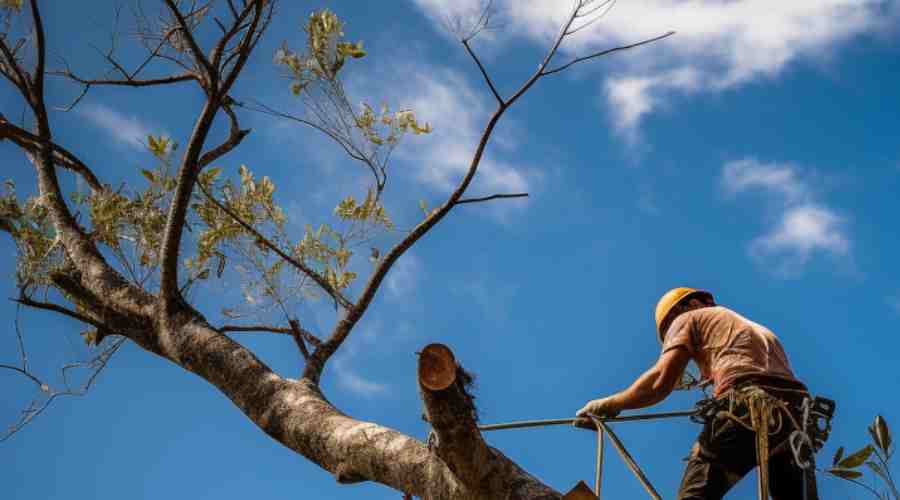Benefits of Tree Lopping
5 Advantages Of Tree Lopping Services
Tree lopping, also known as pruning or trimming, is an important maintenance task for the health and safety of trees on your property. Professional tree loppers judiciously remove branches to improve the structure, appearance, and overall viability.
While lopping sounds harsh, proper technique by a trained arborist promotes vigor by removing dead or diseased wood. Strategic trimming directs growth patterns and balances the tree canopy. Trees also regenerate quickly after pruning if done methodically according to scientific guidelines.
Below we will explore the top 5 reasons why lopping is beneficial for residential and commercial trees.
1. Tree Health
Like a haircut invigorates person, lopping away unhealthy limbs bolsters the tree’s wellbeing. Dead, damaged, and pest-infested branches sap energy as the tree tries healing itself. Removing these reduces risk of disease, insects, and decay which could spread to the trunk or roots.
Thinning the treetop allows more air and sunlight penetration too. Photosynthesis and energy production increases when leaves have room to fully develop without crowding.
Proper lopping removes weight stress as well. Excess branches overload the tree structure leading to cracks or breakage over time. A twig haircut redresses balance issues, especially onolder trees.
2. Safety
Trees located near homes, outbuildings, and public spaces require careful pruning to reduce safety hazards. Overhanging branches can snap and fall during storms. Branch obscuring street signs or growing into utility lines also cause issues.
Tree lopping removes dead wood and overextended limbs before they become risky. Qualified arborists assess trouble spots most likely to drop branches on roofs, vehicles, or pedestrians below. Customized trimming solutions target potential threats.
In addition, lopping opens up views to increase sight lines for traffic, signals, and lighting safety. Neighborhood security improves when landscaping no longer conceals nor impedes visions.
3. Aesthetics
Let’s face it. An unkempt tree looks messy even if it stays green. Random branch patterns with little foliage due to interior crowding have an unbalanced appearance.
Proper lopping creates an attractive shape by controlling wayward branches. Experienced arborists visually assess how to redistribute growth for harmony. This sculpting technique enhances natural form for curb appeal.
Strategic cuts also guide trees into spaces allowing them to reach maturity without detriment. It takes skill and experience to restrict height or breadth through lopping without harming the specimens.
In addition, clearing lower branches raises levels for better views. Trees then showcase architectural attributes like interesting bark, branching structures or colorful flowers now visible to appreciate.
4. Property Value
An appealing landscape sets the stage for higher home prices upon selling. Trees make up a key aspect of that first impression beyond the front door. Well-placed quality trees can boost property value by 20 percent.
However, buyers get turned off by overgrown trees that look hazardous or interfere with home functionality. A value engineering regular tree trimming helps improve real estate marketability.
Tree maintenance removes growth impeding architecture and clears broken or unsightly branches. Touching up other landscape elements also upgrades the lot. Curb appeal directly correlates to offer price and time on market.
5. Sunnier, Drier Environment
Trees provide wonderful shade. But sometimes too much shade over grass, gardens or homes creates problems. Dense shade prevents lawns and landscape plants from thriving. It also fosters fungal issues and erosion from constant moisture.
Likewise, some homeowners complain dark, damp conditions due to tree cover promote mold and mildew issues indoors. Rooms lack sufficient sunlight to dry out moist air leaking through foundations.
Tree lopping helps remedy these problems by thinning and raising canopies. More sunlight permeates while allowing better airflow circulation. The brighter, drier environment then alleviates several landscaping, building envelope, and indoor air quality issues.
DIY Tree Lopping Tips
Many homeowners try to prune trees themselves to save money. But doing it wrong can permanently hurt the tree. Trees don’t heal like people. Damaged areas stay open to pest infestations and rot.
Follow these rules to safely trim trees yourself:
- Make sure no power lines run through or near the tree. Call the utility company if lines are close. Have them moved before cutting trees near a house.
- See which way the tree leans. Plan your back cut so the tree falls that way, away from buildings, fences or other stuff.
- Clear escape paths before cutting. Guess how tall the tree is. Remove anything below it that could get hit if the tree falls the wrong way. Go twice as far away from the trunk before cutting to avoid injury.
- Use sharp blades and cut carefully. Bad cuts leave ragged wounds for bugs to eat.
- Never climb high to cut branches you can’t reach from the ground. You could get badly hurt.
- Wear goggles, ear protection, steel-toe boots, chaps and a hard hat when running equipment.
Leave the tree care to certified arborists when possible. Proper pruning keeps trees healthy and eliminates hazards. Contact a professional tree service to see which dead branches need removal.
In Summary
Tree lopping gives numerous benefits than just basic pruning. Doing it right improves the tree’s health, shape and lifespan.
Thinning the overhead also lets in more sunlight below. This helps plants, lawns and outdoor areas. It even makes indoor spaces brighter and less humid.
Lopping makes entire trees look nicer too. That can increase a home’s selling price.
So don’t avoid lopping if advised by tree experts. This proactive care benefits all kinds of tree species in the yard. Licensed arborists can quickly remove problem branches hampering your trees.


